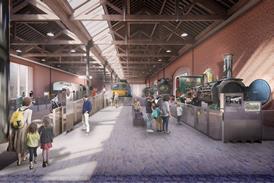- Home
 City of London to appoint architect to design firearms training facility for City police
City of London to appoint architect to design firearms training facility for City police Carmody Groarke gives preview of its revamped Manchester museum ahead of summer reopening
Carmody Groarke gives preview of its revamped Manchester museum ahead of summer reopening TP Bennett’s rethink on Canada Water scheme set to be approved next week
TP Bennett’s rethink on Canada Water scheme set to be approved next week What’s stopping us from better understanding our emissions?
What’s stopping us from better understanding our emissions?
- Intelligence for Architects
- Subscribe
- Jobs
- Events

2025 events calendar Explore now 
Keep up to date
Find out more
- Programmes
- CPD
- More from navigation items
Why it's in all our interests to reinvent the almshouse after 1,000 years

While the last decade has seen significant progress in the quality and variety of housing for older people, there is still some way to go
We hear a lot about the fact that the UK housing market needs to respond to changing lifestyles – more build to rent, shared living, micro-homes and so on. Almost all of this is focused on young people, implying that they are the only group whose living patterns evolve.
That’s always been the assumption. England’s first almshouse was built in 936. For almost 1,000 years, these carefully crafted buildings remained the only decent form of housing for “older people” (that meaningless phrase that we all use to describe anyone a decade or so older than we are) who lacked the means to support themselves. Charming though they were (and many still are) the implication is that “old people” have always been “all the same”.
Sheltered housing didn’t appear until the second half of the last century. Early models were mainly council-built, but by the mid-Seventies the need for a private-sector equivalent was identified. Soon, McCarthy & Stone was everywhere. But despite latent demand and the quality bar set by the almshouse precedent, no one seemed to think that design mattered. Slightly more thought was given to the design of extra-care housing (a re-branding of “very sheltered”) that came on the scene in the 1990s, but they were easily mistaken for three-star hotels.
…
This is premium content.
Only logged in subscribers have access to it.
Login or SUBSCRIBE to view this story

Existing subscriber? LOGIN
A subscription to Building Design will provide:
- Unlimited architecture news from around the UK
- Reviews of the latest buildings from all corners of the world
- Full access to all our online archives
- PLUS you will receive a digital copy of WA100 worth over £45.
Subscribe now for unlimited access.
Alternatively REGISTER for free access on selected stories and sign up for email alerts


